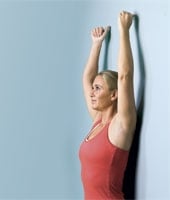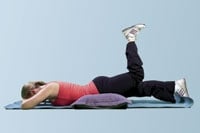
Our joint-healthy osteoarthritis exercises will help your joints move more smoothly and increase your range of motion.
More than 100 types of arthritis exist, affecting people of every age, physical condition, and ethnicity. According to the Public Health Agency of Canada, about 60 percent of Canadians with arthritis have difficulty participating in recreation or leisure activities, though keeping active is key.
Osteoarthritis (OA) is the most common form of arthritis. It affects the joints in the body; particularly the hands and the weight-bearing joints of the hips, knees, feet, and spine. The exact cause of OA is unknown, but what is known is that being overweight and sedentary dramatically increases the risk of getting osteoarthritis, especially in the hips and knees.
The ins and outs of OA
In a healthy joint, the material covering the ends of the bones—cartilage—acts as a buffer and a shock absorber when there is movement in that joint. The ends of the bones are also coated with synovial fluid, which allows each bony end to glide freely. Those plagued with OA have cartilage that is rough and thin, and the synovial fluid is thick and inflamed. Add the two together and you have a joint that is painful, suffers from a loss of mobility, and in severe cases is deformed.
Feed your joints with exercise
The Arthritis Foundation states that losing as little as 11 pounds can cut the risk of developing knee OA by 50 percent for some women, and losing 15 pounds can cut knee pain in half for many of those who are already suffering.
Exercise can also help liquify the synovial fluid, allowing the joints to glide easier, and it also “feeds” your joints. Cartilage—the buffer that protects the ends of bones—depends heavily on joint movement to absorb nutrients and remove waste, which means that for every step that you take you are not only strengthening the muscle and tendons surrounding that joint, you are also helping the cartilage and making it less susceptible to OA.
Try these three range-of-motion exercises daily to help keep your joints healthy and pain-free.

Knee to chest
- Lie on your back and pull your left knee up toward your chest by placing both hands behind the knee. Keep right leg straight, with the heel pressing into the ground.
- Using your arms, slowly pulse your knee toward and away from your chest 12 to 15 times and then hold the knee in for 20 to 30 seconds.
- Repeat using the other leg.

Forward arm lift
- Lean your back against a wall keeping your bum, lower back, shoulders, and head pressed against it while your feet are a few inches in front.
- Pull your lower back in towards the wall by drawing in your abdominals and set your shoulders back and down.
- Extend both arms down by your sides with palms out. Now lift both arms up and above the head, leading with the thumbs. Touch your thumbs to the wall. Continue lifting your arms up and down for a count of 15 times.

Back leg lift
- Lie on your stomach with a pillow under your hips. Place your forehead on your fists to keep your neck in line with your spine. Bend the right leg so that the knee is bent at a 90 degree angle.
- Contract the abdominals and slowly lift the front of the right leg up and off the floor, pressing the heel up to the ceiling. Hold the leg up for a breath and then slowly lower.
- Perform 12 to 15 times, then switch and repeat with the right leg.
Exercising with osteoarthritis
If you have severe OA, check with your physiotherapist before you begin an exercise program.
As well:
- Allow for a longer warmup before your exercise session—10 to 15 minutes of light activity is recommended prior to any aerobic or strengthening workout.
- Begin slowly and progress gradually.
- Avoid repetitive or rapid movements to the affected joints.
- Set aside at least a few minutes every day for range-of-motion and flexibility exercises (such as the three listed in this article).
- Add 30 to 60 minutes, three days a week of strengthening exercises and aerobic activities (such as walking, biking, or swimming). If that is too hard for you to fit in, then aim for 15 to 20 minute segments, twice a day.
- After exercise, observe the two-hour rule. Muscle or joint pain that lasts more than two hours after the exercise means you probably did too much too fast.
- Check out your local recreation centre’s programs for “Joint Works” or “Water Works”. These programs were developed by The Arthritis Society of Canada.




